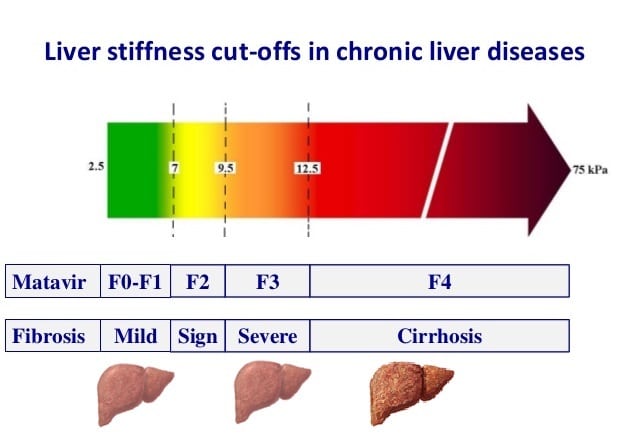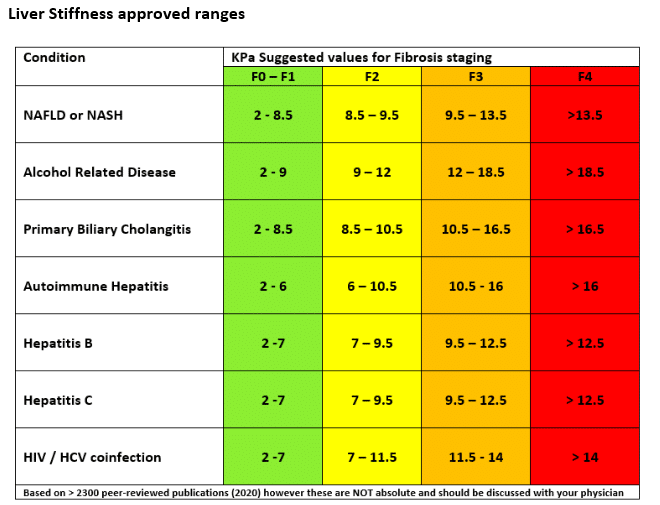Your liver plays a vital role in your overall health and wellbeing, and understanding liver stiffness is essential in helping you maintain a healthy liver and lifestyle. In this latest article, we will take a closer look into what liver stiffness is, how it is diagnosed, the health implications behind it and how to interpret and act upon your results.
What Is Liver Stiffness?
Before we look at how the condition is measured, it is important to firstly answer the question, “What is liver stiffness?” The term refers to how soft or hard the organ’s tissue is, which can indicate potential liver diseases, particularly those involving fibrosis and cirrhosis.
A healthier non diseased liver is usually soft
The condition is primarily caused by the build-up of scar tissue, which can be caused by a range of factors, including:
– Chronic Hepatitis B and C
– Non-Alcoholic Fatty Liver Disease (NAFLD)
– Alcoholic liver disease
– Autoimmune hepatitis
– Rare Genetic condition
Liver stiffness is measured using non-invasive methods, such as a FibroScan®. This powerful test is able to indicate the overall health of the liver and whether medical attention is required.

Understanding FibroScan® Technology
FibroScan® technology, or vibration controlled transient elastography (VCTE) as it is also known, is a cutting-edge, non-invasive (does not go into the body) diagnostic tool that assesses liver stiffness. Technology plays a vital role in the early detection and monitoring of liver stiffness, which helps to improve the early identification, diagnosis and monitoring of poor liver health and disease.
The test works by utilising a special probe that is placed against the skin over the liver. This probe emits a series of low-frequency sound waves that pass through the tissue and the speed at which they travel indicates the stiffness of the liver. This makes the test very safe even in children, pregnant women and those with pacemakers.
This innovative technology offers a number of advantages over traditional methods of assessing liver health, including:
– Non-invasive
– High negative prediction for no liver damage
– Earlier detection,
– Patient comfort, and,
– Speed and efficiency.
Preparing For Your FibroScan® Test
Now that we understand what liver stiffness is and have reviewed the technology used to diagnose it, what do you need to do to prepare for your test? It can be nerve-racking, but the process is very simple and painless.
Before your liver stiffness test
It is recommended that you avoid drinking any alcohol for at least 24 hours beforehand and avoid any food for at least three hours. This helps stabalise the blood flow through the liver and improve the accuracy of the results.
You should also consult with your doctor about any medications that you are taking. Most medications will not interfere with the results, but it is always wise to check.
Wear comfortable clothing
On the day of your scan, wear loose and comfortable clothing. This will ensure easy access to the right side of the abdomen for the FibroScan® probe.
Relax and stay calm
While some people can be nervous with any kind of scan, take your time and discuss any concerns with the staff. For some patients the FibroScan® test tickles.
Arrive in plenty of time
Make sure you arrive in plenty of time. This can help you to relax and prepare mentally for the examination.
What Do The Results Mean?
FibroScan® measures the liver’s stiffness in Kilopascals (kPa), with a normal healthy liver or one not at risk is one a specialist considers that scores under SEVEN. Mild fibrosis can for some be indicated by a score between 5 and 8, and may suggest some scar tissue is present. Minor lifestyle interventions are essential at this point to improve your health.
This will depend if you have an underlying liver diagnosis as there are rare liver diseases that scarring is indicated in lower readings.
A ‘moderate’ advancing fibrosis score is considered above 8 and at this point you will be referred to see a specialist as this maybe indicating greater scar tissue and damage. Anything greater than 12.5 kPA may indicate advanced fibrosis and possible cirrhosis, a serious condition in which normal liver tissue has been extensively replaced by scar tissue.
There are many reasons that may affect the stiffness scores including not fully fasting, liver inflammation and heart failure and this will be discussed with you at the scan and is why higher readings require specialist assessment. FibroScan® is one of many tests that assess liver health.
The FibroScan® will also be able to measure the levels of fat that have accumulated in the liver using the Controlled Attenuation Parameter (CAP). This is measured in decibels per metre (dB/m), with healthy levels under 248 dB/m and fatty liver over 248 dB/m.

Comparing FibroScan® With Other Liver Tests
Traditional Liver Function Tests (LFTs) are NOT very effective at identifying liver health and measuring the levels of the enzymes, proteins and bilirubin in the blood. When compared to a FibroScan®, the two tests differ in several ways:
Assessment Focus
An LFT can indicate liver function and damage through enzyme and protein levels, whereas FibroScan® measures the stiffness change in the organ.
Diagnostic Information
A FibroScan® offers more detailed insight into the possible degree of fibrosis and the presence and levels of liver fat. An LFT is able to provide information about liver cell damage, bile duct formation and protein synthesis.
Clinical Practice Use
In medical practices, LFTs are used for initial liver disease screening and ongoing monitoring of liver function. In those detected with abnormal liver tests a FibroScan® is used to assess for and monitor liver fibrosis and fat.
In those with normal tests and abnormal FibroScan® then the doctor will do further assessments based on the FibroScan®.
Factors That Can Affect Your FibroScan Results
There are a range of factors that can impact your FibroScan® results. Understanding what these factors are, can help you derive the most accurate results. The first consideration is food, particularly heavy or fatty meals, which is why it’s advised you fast for at least three hours before the test. Alcohol could also impact liver stiffness results, so avoid drinking any for at least 24 hours.
A high Body Mass Index (BMI) can affect the results due to the depth of skin to the liver that the waves need to pass through. Other health conditions can also impact the results, particularly liver inflammation, congestive heart failure and cholestasis.
Next Steps After Receiving Your Results
After you have received your results which may be done by the specialist nurse who did your scan they will talk you through what they mean and what steps you can take or if you require further specialist assessment and referral. The first step is often to make lifestyle changes such as eating a healthier diet, reducing your alcohol intake and increasing your water intake. and these can often be started immediately. Increasing physical exercise within your ability is also important to help you maintain a healthy weight.
In more severe cases that require referral, once the disease is diagnosed the doctor might recommend medical intervention. This could be to treat viral infections such as hepatitis, or to treat the fibrosis directly. They will also likely recommend regular monitoring to check for any changes.
Interested In A Consultation?
If you have a family history of liver disease, cirrhosis or liver cancer or are just are looking to determine the health of your liver and assess if you have fatty liver and what steps you may need to take to improve your wellbeing, then our team at Tawazun Health is here to help you. As a leader in access to early diagnosis and assessment of liver disease, we utilise cutting-edge diagnostic solutions to deliver comprehensive insights.
Want to find out how Tawazun Health can help you or your organisation? Make an enquiry today!

